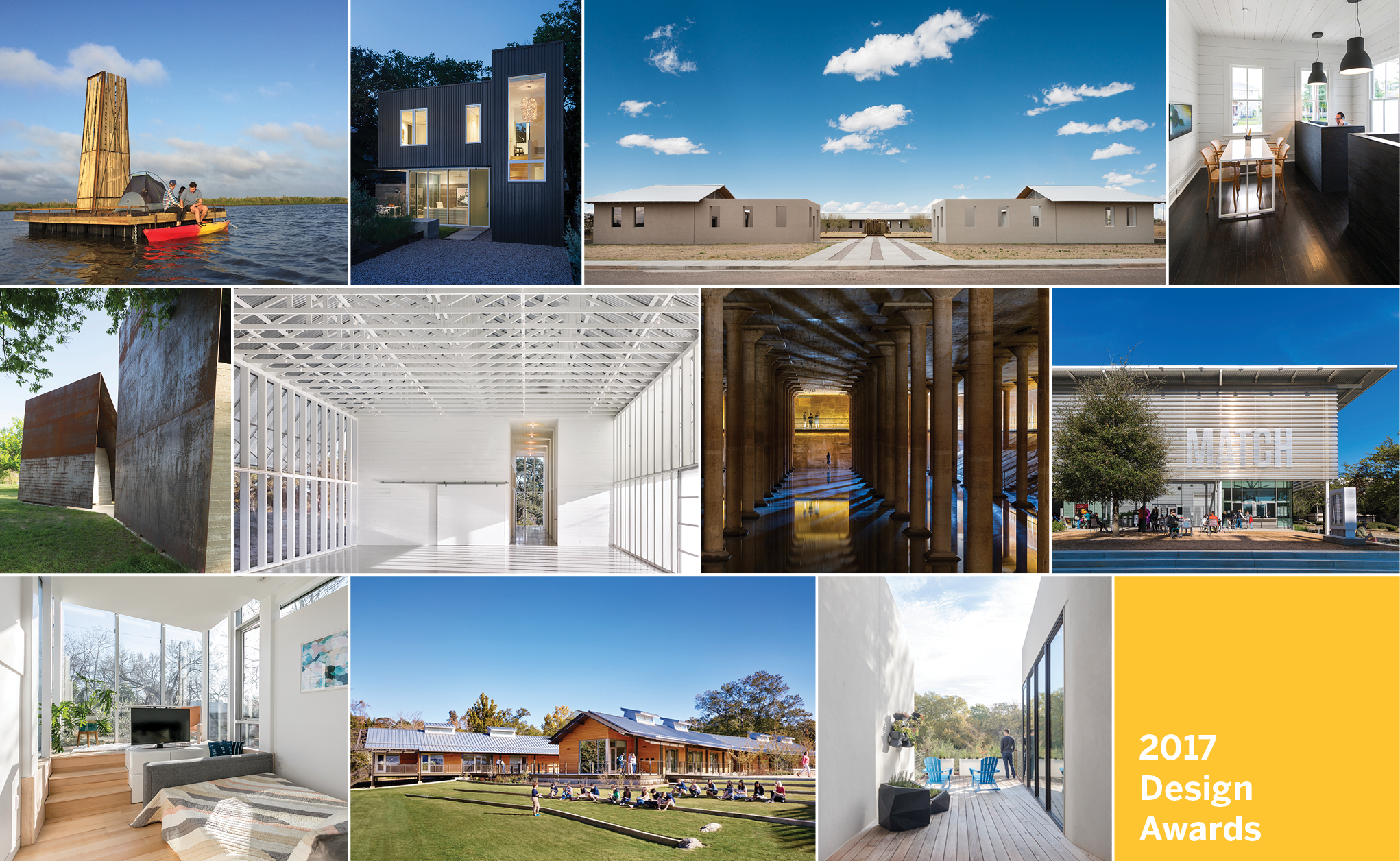Announcing our 2017 Design Award winners, as selected by David Miller, FAIA, Julie Snow, FAIA, and Andy Tinucci, AIA, last Thursday and Friday in Austin. Our distinguished jury deliberated over 313 projects before selecting 11 to honor. Congratulations to the winners! Their projects will be featured in the September/October issue of Texas Architect.
In no particular order, the projects are:
Hillmont Studio, Patrick Ousey, AIA

“Doing an accessory dwelling unit in and of itself is not terribly remarkable, but certainly a good thing for density within the city. But this one was able to achieve a really striking balance of privacy for the original home and the accessory dwelling unit. It had outdoor areas that really lent themselves to be part of the unit. It looked like a great place to live.” —Julie Snow, FAIA
Micro Smart Home, Kasita

“I mean, this was again, sort of understanding architecture in a broader sense. It’s not just a site-specific piece of work, but it’s identifying and filling a need. What I think was particularly exquisite about the project was detailing this for a maximum impact and living space within 350 sf. There was just this remarkable achievement there.” —Julie Snow, FAIA
Midtown Arts and Theater Center, Houston, Lake|Flato Architects

“It’s an institutional project that really tries to expand the public street into the project. The idea that the theater lobby is actually a covered internal space to the building but still an exterior space, a public space, is really an exceptional concept.” —Andy Tinucci, AIA
Winnwood Residence, 5G Studio Collaborative

“It’s beautiful, it has a lot of sustainable design features, it has geothermal mechanical systems, it’s got a cistern that captures rainwater, it’s LEED platinum. So it has all of these great environmental attributes, and at the same time, it’s beautiful architecture.” —David Miller, FAIA
Kane Street Office, Michael Morrow, AIA

“It’s an adaptive reuse project and a preservation project, but an atypical one, an unconventional one. Not preserving a canonical historical structure, but just preserving a lovely old building and adaptively reusing it in an incredibly clever way.” —Andy Tinucci, AIA
The Robert Irwin Project, Ford, Powell & Carson

“I think this is an incredible piece. It was definitely on our shortlist immediately, obviously, not only because of the power of Irwin’s work, but of the collaboration and the sort of blurring of the distinction between where art stops and architecture starts. To me, there’s something incredibly powerful about that blurring and that lack of distinction. And I think it challenges architecture to be as powerful as that particular project every time.” —Julie Snow, FAIA
FLOAT, Gulf Coast Design Lab

“I have a soft spot in my heart for student design projects that get constructed. I think it’s really important for our schools of architecture to have design-build projects…but design-build needs to be more than just about constructability. This project is remarkable because it has very ambitious goals of creating this great place in this marshland.” —David Miller, FAIA
Indian Springs School, Lake|Flato Architects

“The school falls into the category of a standard typology that we always need to think about improving upon, and this school absolutely does that. The Indian Springs School joins students with the environment seamlessly. I think the sectional quality of the classrooms is really one of the outstanding design elements. They’re an unconventional look at a conventional typology.” —Andy Tinucci, AIA
Prospect House, Max Levy, FAIA

“To take this kind of Hallmark greeting card kind of event and to turn it into something that is much more crisp and much more invented and much more connected to the landscape, I thought was just fantastic.” —Julie Snow, FAIA
The Cistern, Page

“The Cistern project was just like this discovery. So you’re flipping through millions of images and suddenly you come to this space that’s incredibly powerful. Up until now, the architect maybe hasn’t had a role, but when he comes in, he restricts his insertion to just a small entry piece and a walkway boundary and concealed lighting. Done. I mean, what a simple way to actually create this extraordinary experience.” —Julie Snow, AIA
Lady Bird Loo, Mell Lawrence, FAIA

“We’re often asked to do projects in parks, and parks are challenging places to place architecture because a natural parkland is a place there shouldn’t be any architecture, frankly. We don’t want buildings in parks, we want nature in parks. And this project does a really nice job of sensitively placing a necessary facility inside of a parkland by becoming the landscape. The form anticipates itself as landscape, potentially, the ground plane folding up and over the use.” —Andy Tinucci, AIA

